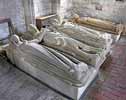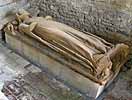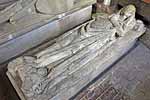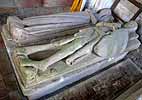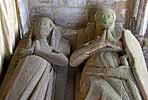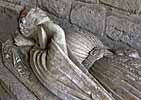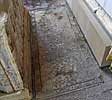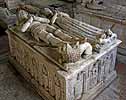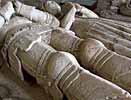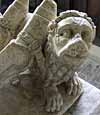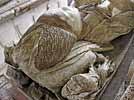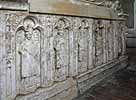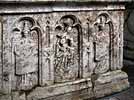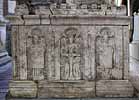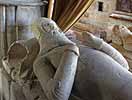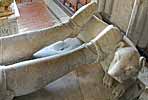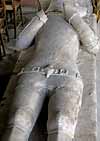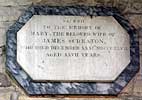For this church:    |
Willoughby-on-the-Wolds St Mary and All SaintsMonuments and MemorialsNorth ChapelThe Willoughby Monuments
The monuments are sited in the north chapel of the church, which was originally a chantry chapel. It was constructed from Triassic sandstone and opens on to the north by two large moulded arches supported by a central moulded pillar. The easternmost bay is partly occupied by a panel with two blind trefoil arches. The four stone figures lying at the west end are the oldest. Little is known of the two ladies lying side by side in an attitude of devotion. The monuments to a cross-legged knight and lady are usually attributed to Sir Richard de Willoughby, grandson of Ralph Bugge and was Commissioner of Oyer and Terminer in 1311 and 1314. He appointed that ‘his body be buried in the church of All Saints, Willoughby before the altar of St Nicholas’.
The alabaster altar tomb adjacent to the north wall of the chapel is that of Sir Richard de Willoughby, son of the previous of similar name, who died in 1362. He was a Justice of Common Pleas for 28 years at the time of Edward III and acted as Chief Justice during the absence abroad of Chief Justice Scroop. He wears an embroidered robe with a close collar, which is buttoned down the front, and a small close cap. A sword of justice hangs at his right side and his feet rest on the figure of a dog.
The double altar tomb of alabaster, which occupies the middle of the chapel, is that of Sir Hugh Willoughby. He married Isabella Foljambe, whose grave is under the floorstone beside the tomb. His second wife who rests by his side was Margaret Freville, who brought the Middleton estates into the family. The lower part of the tomb is surrounded by angels, each holding a shield. At the East end of the tomb, is a representation of the Virgin and child, whilst at the west end is a representation of the Holy Trinity. Fragments of an alabaster sword were found inside the tomb when it was restored in 1984. The fragments are now in a display case on the north wall of the chapel. Sir Hugh died in 1448 and was the last of the Willoughby family to be buried at Willoughby. He bequeathed to the altar of the Chantry in Willoughby ‘in repairing ornaments 20 shillings’.
Under the eastern arch leading into the church lies a plain altar tomb bearing a recumbent alabaster figure, thought to be Sir Richard Willoughby, eldest son of the Judge, who died in 1369. He wears a conical bascinet, to which is attached the camail (hood) of mail and on his jupon may be seen the Willoughby coat of arms. A highly ornamented belt encircles his hips, from which the sword and dagger have been broken. At his feet is a couchant lion. His head rests on a helmet and his hands are in the devotional attitude. He married a sister of Lord Grey, of whom no effigy remains, but her coat-of-arms are displayed on the tomb.
Major restoration work to the tombs and repositioning of the effigies took place in 1983. There is a cross slab floor stone beneath the altar in the north chapel, probably to Hugh Willoughby, Rector of Willoughby who died c1344 (see Archaeology for further details). North AisleOn the floor of the north aisle is a brass plaque to Colonel Michael Willoughby: 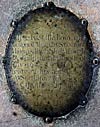
Partly concealed beneath the organ is a cross slab floor stone to a member of the Willoughby family (see Archaeology for further details). South AisleOther monuments in the church include a white stone wall plaque with elongated octagonal marble surround on the south wall of the south aisle. The inscription reads: | |||||||||||||||||||||||||||||||||||||||||||||



